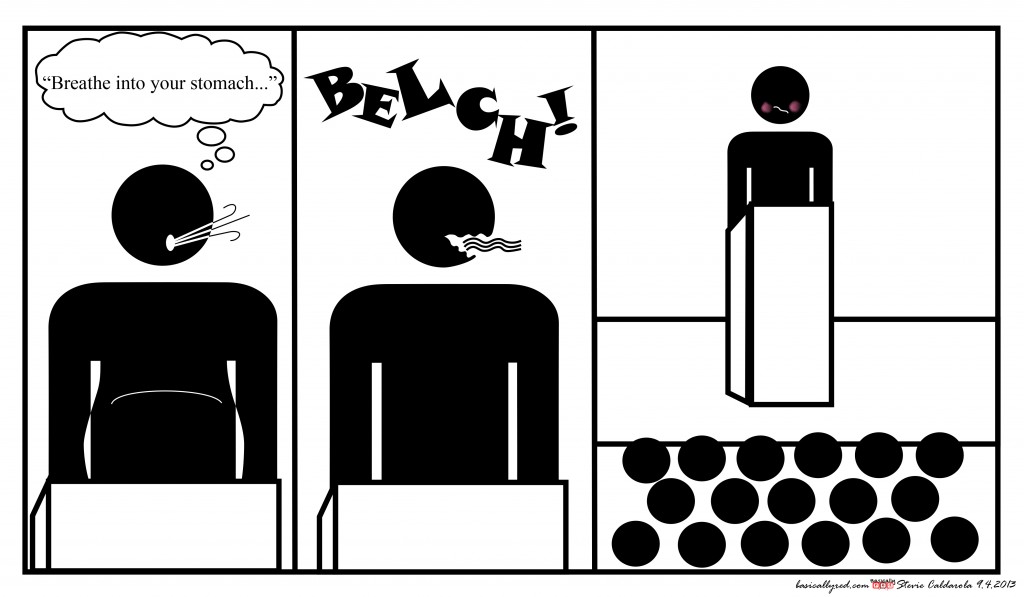Ok, perhaps that should be poor breath use is bad for business. Breath powers our voices that we use for our business communication. Poor breath use can lead to poor voice use, which can be heard as an annoying or shrill voice or perceived as someone being closed off or insincere, among other things.
Some of the guidance out there on blogs and websites that are well-meaning suggests ways to work on public speaking that can lead to misleading information and ideas.
Please do not breathe into your stomach – if you do so, you will simply burp.

What’s wrong with teaching breathing in our lungs? Why do we say breathe in the stomach – which is an organ for digestion of food? Why do we say breathe in our belly – which is a little less misleading because it is a general area? Why do we say breathe with your diaphragm? Have you tried breathing without your diaphragm? Again, why do we not say breathe with your lungs? *
OK, I’m on a rant now – and why do I care enough to rant?
I care about the ease of using the voice and the authentic sharing of message and voice without making it complicated. The emotional element of voice is complicated enough. Communicating is complicated enough. I like to remember that breath and voice are simple – it’s really only ourselves who get in our own way.
It’s a simple process in a really complex system: a signal is sent to the diaphragm to engage and expand the lungs, creating a vacuum that allows air to rush into the lungs. We let the air out, and it passes between the vocal folds, which vibrate with the airflow and make sound. We shape the sound as it travels up and out. Voice.
So what’s got me all bothered? After years of teaching voice, I believe that the use of images has taken us further from the ease of breathing, far from the ease of a loud and powerful voice. We have made it complicated. How can it be complicated if we were able to cry and wail with no loss of voice as soon as we were born? We have lost touch with the ease. We breathe in our lungs. Our ribs expand mostly upward and outward to make room for the expanding lungs. Then with ease and no tension in our shoulders, neck, and larynx, we can let forth an amazing scream or a touching coo – or lead a meeting, give a keynote or even sing a song.
When teaching breathing, there is a historic reliance on imaging – breathe into your stomach or your belly – which invokes images of expansion far below where we actually physiologically breathe. The release of tension in our belly that allows movement of the spine and abdominal muscles is helpful for increased space and movement for breath – and yet we are still breathing in our lungs.
And then there is the common suggestion to breathe with your diaphragm – as if breathing with your diaphragm is an option. The diaphragm is engaged in all breathing whether shallow or deep. (Unless there is paralysis and then secondary muscles must be engaged to compensate.) We have no conscious control over engaging our diaphragm. The diaphragm is a flat, dome-shaped muscle that we can’t touch nor see from the outside of the body. We can suggest a release of the abdominal muscles so the diaphragm can drop lower, freeing up more space to allow more air to enter. And these directions often have no mention of the organ that is, quite literally, a necessary part in breathing – the lungs. I realiz it’s obvious, but we don’t breathe in our stomachs. We breathe in our lungs.
How about “remember to release your abdominal muscles so the diaphragm can drop while releasing your intercostal muscles to allow the maximum space for the air to fill your lungs?”
All singing and speaking voice teachers and clinical voice therapists, too, are essentially going after the same result: get tension out of the system so the breath can flow and voice can be released fully and powerfully.
I have laid on many a floor and felt my hand rise and fall on my belly as I inhaled and exhaled. As an actor, teacher, and voice specialist, I have found it helpful to explore my instrument and get a sense of release and ease. But it is not necessary for voice work.
As I work with business professionals on their voices, two things are important to note: time is short and expansion of the belly in public is not usually going to happen. You can work with someone all you want to help them achieve a relaxed belly breath, but when they step up to speak in public, there is a good chance that their belly will be sucked in and they will revert to a high clavicular breath, which works to keep you alive, but is not efficient for long term nor loud speaking because it causes tension in the upper chest and larynx which can be potentially harmful.
Efficient breathing for speaking involves the breath dropping into the lower part of our lungs for a fuller breath. There are nifty little muscles, intercostal muscles, between and over our ribs that expand and allow our lungs to expand outward – sideways and to the back (yes, the back) and some to the front. Many of us connect with this breathing technique if we are asked to get in the physical stance of some sport or physical activity in which we engage – ski, bike, softball, baseball, golf, picking up a child. This is different from the high chest breathing that often involves less movement of intercostal muscles for shallow breathing. Some of us have not felt our intercostals move in quite some time. Others of us have, but not in connection to breath.
Throughout the day, many of us breathe more shallowly, sometimes called “sipping” or “clavicular” breathing. There is nothing wrong with this breath, as it also allows the blood to drop off CO2 and pick up O2 to deliver through the body. If not speaking or exerting, this more shallow breath works just fine going about our day. We have a wide spectrum of use for this breathing process from, “I need air now, any way I can get it,” often called the freeze/fight/flight breath – which involves a quick intake that lets air into the top part of the lungs, to the optimal release and relaxation that allows for optimal flow and voice control.
Overemphasis on belly breathing, although helpful to get the breath low in the lungs, can lead to a locked or unmoving rib cage. In an attempt to move away from the clavicular or high shoulder breathing, we have moved so low to the belly area that we’ve missed the primary location for expansion, and thus, power for our voices.
Many people, then, compensate for lack of air for the voice by pushing from the neck. When the power source and the sound source are both in the neck, we end up with tension that can cause strain on the voice, often leading to a tight sound.
Since our voice is an important component of who we are and what we share with others, the tension and tightness can come across as closed off and/or nervous and lacking confidence.
Throughout our day we may come in contact with a number of people. Often the shallow breath is sufficient, and in some ways keeps us from getting too connected to everyone we meet. That can be exhausting: deeper breath, deeper connecting, shallow breath, more superficial connecting. Both are important options in our day-to-day life. Our breath is who we are. When we share our breath, we share ourselves.
When speaking involves being nervous or protective, we tend to breathe higher in the chest – the clavicular breath. We are in freeze/flight/fight mode versus the relaxed breath that is more efficient and effective for speaking and often happens when we are feeling comfortable. Our job as speakers and trainers of speakers is to be able to access the relaxed and powerful breath on demand in order to share our message with authority and authenticity.
Most Efficient Power Source: air from the lungs
Most Common Sound Source: air passing through the vocal folds
Most Effective Voice: what is shared outside of the mouth
Just a reminder: Exhaling first helps. Our breathing is based on a vacuum. Exhale, relax the muscles around the rib cage, and feel the expansion sideways as the air rushes in. Many teachers and speakers will suggest to a group, “let’s take a big, relaxing breath,” and most often we see shoulders rise and chests puff throughout the group. Exhale first, and let the air flow back in as the intercostals relax, allowing the ribs to expand with the filling of the lungs.
A few exercises to help feel and focus on the lung and side breathing:
-
- While seated, lean over, your belly pushed against your lap, and feel the breath come into your back
- Imagine engaging in a sport you do, and feel expansion in the ribs
- Wrap your arms across your lower chest with hands on side ribs – exhale and feel the air come back in and the ribs expand.
- Run in place until slightly out of breath, and feel the air in your lungs move the ribs.
- Stand against a wall and imagine breathing into it, making a connection between your back and the wall.
If the image of breathing into your stomach or belly works for you – go for it, but once in awhile remember that you are really breathing into your lungs.
Written with physiological guidance from Jennifer Spielman, MM, MA, CCC-SLP.
*With all due respect to and acknowledgment of the amazing voice teachers with whom we have had the privilege of working: Chuck Jones, Rocco Dal Vera, Gary Logan, Patsy Rodenburg, Catherine Fitzmaurice and Kristen Linklater – to name a few.



